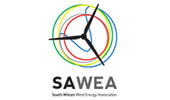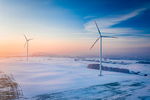News Release from South African Wind Energy Association (SAWEA)
Wind Industry Profile of
Wind Industry Adopts a Charter to Address Impact and SA Development
“It has been rewarding to coordinate the drafting of the Industry commitment to South Africa and in the process to consider what we are able to contribute to socio-economic transformation over a 20-year time horizon,” says Brenda Martin, CEO of SAWEA. Traditionally, Industry charters are made with hindsight by mature industries. Recognising the opportunity to set a vision early on that can serve as a touchstone for the maturing Industry, the relatively young SA Wind Industry makes this commitment at a vital moment in its growth.
“Being aware of the fears experienced by those affected by the energy transition underway in South Africa, we are articulating our ability to making meaningful contributions to employment creation and socio-economic transformation,” she says.
The Commitment Statement notes some distinct industry features, which can be leveraged:
- The REIPPPP has a built-in demand for local procurement, which not only offers business opportunities to local companies, it also incentivises the Industry to identify emerging entrepreneurs, especially in rural areas, and assist them to achieve high performance goals.
- The industry is able to use its own clout to assist emerging entrepreneurs in accessing finance.
- Contract terms demand that wind industry players seek opportunities to make contributions to local social and economic development within each operator’s catchment area (a radius of 50 kilometres). This has evolved; companies now able to voluntarily extend their activities while meeting their contractual obligations, with the aim of making long-term impacts beyond compliance.
- The industry sees opportunities to sculpt a management and employment profile which reflects a fair and ethical culture that enables skills development and advancement for the young, the disadvantaged and for women; and to grow a people and ownership profile reflective of the demographics of our country.
“Our aim over time is to transform and indigenize leadership at all levels in the South African Renewable Energy sector,” says the Commitment Statement.
Transformation of industries and communities through localisation, skills development and socio-economic interventions support the goals of the NDP and local development plans.
With several rounds of accepted bids behind them, key members of SAWEA have had some years of experience in implementing the requirements engineered into the contracts. With the Commitment Statement for the industry, they are crystallising what they have learnt, and taking the opportunity to express an important outgrowth of the terms under which they operate: a unique further commitment to the country and to the people.
“This is the springboard upon which this young industry can grow,” says Martin. “It captures what we’ve learnt thus far and crafts that insight into a foundation for creating a flourishing future; a foundation that is solid but also flexible, capable of adapting to evolving socio-economic transformation needs.”
Collaboration is key
One of the task team members involved in shaping the Commitment Statement is Toni Beukes, Country Manager for Vestas Southern Africa and Chairperson of SAWEA’S Wind for Communities Working Group. The commitment for this young industry has a very different time horizon than charters and other similar documents which aim to reverse-engineer conditions in other mature industries, says Beukes.
“Most of our businesses represent long-term investments in the physical, social, environmental and economic fabric of this country,” and that is an industry strength, the Commitment Statement notes.
The arc of impact for socio-economic interventions takes us 20 years into the future, Beukes says. Over that period, significant funding will be generated – the first three rounds of bidding alone have produced over R1 billion for local community development. The potential inherent in ample time and ample funding has drawn industry players into collaboration.
“Funds and effort will have more impact if we work together,” says Beukes. “Our reach into communities often overlaps geographically, so we have begun to look for the best ways to collaborate to support socio-economic change locally.”
This sense of collaboration at a broad level, of growing together into a united, fully-fledged industry with deep connections to local suppliers and people, is reflected as a key strength in the Commitment Statement.
A living document
For Lukhanyo Ndube, CEO of Kouga Wind Farm, the Commitment Statement is “not a list of items to be achieved to the T – it’s a conversation document, bringing us all together in discussion as an industry.” Everyone who has worked on this document as part of the industry team has a history, he says: during their working career, they’ve seen many missed opportunities to make a difference while making profits, and they bring these individual experiences and passions to this new industry. They hope to make the most of it: “The Commitment Statement is an expression of what we think we can do, and as the conversation unfolds, the document will improve.”
According to Hein Reyneke, CEO of Mainstream Renewable Power South Africa, the drive to achieve the goals set out for successful bidders had two wellsprings: “Everyone in the industry recognises that we have a responsibility to the country.” On the other hand, there’s also a sense of self-preservation: “If we don’t take up the challenge to meet the demands of the NDP, if we don’t do this properly, then we won’t be able to do what we really want to do – which is produce power. From the outset, we’ve known that this was non-negotiable.”
Like most in this fundamentally people-oriented industry, Reyneke spends a fair bit of time in deep rural areas to which wind installations are bringing opportunity. The poverty trap, he says is very evident. “It’s there, it’s undeniable, it’s in your face.” Seeing this “creates quite a fundamental shift in how you think.” He muses on the difference between the children of this community and his own children: those born into poverty will be unfairly disadvantaged. The wind industry is infused with an urgency to assist with righting this social inequality and injustice.
“The Commitment Statement lays the foundations for the culture of the industry,” he says. “It’s a solid guide based on real-life experience, which can be used in the next phase to make pragmatic choices, to find ways to hold each other accountable, and to set tangible, measurable goals.”
- Source:
- SAWEA
- Author:
- Press Office
- Link:
- sawea.org.za/...
- Keywords:
- South Africa, wind industry, charter, development, SAWEA, association, statement, future

























